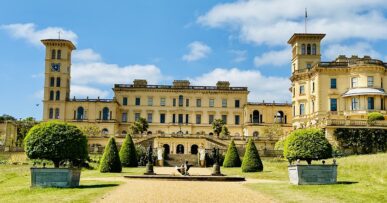- Glorious Gloucester
- The Cotswolds – the perfect place for staycation in August 2021
- Warwick, Packwood, Charlecote – what a feast for the eyes!
- Stratford-upon-Avon in September 2021 – real bliss!
- Leamington Spa – the oft-overlooked gem of Warwickshire
- Henley-in-Arden via Newbury and Banbury
- Hereford is a secret well worth discovering
- Ross-on-Wye – the birthplace of “Picturesque Tourism”
- Leominster or Ledbury?
- Whitchurch – where? Why?
- A+ for Ardencote and Alcester!
- Long weekend in Warwickshire
- Captivating Cambridge
- February hotel breaks – Salisbury & Bournemouth

Leominster or Ledbury?
From my research, both towns are easily accessible by train from Hereford
Both are famous for their black and white timber-framed buildings, a feature of this area. To avoid seeing much of the same, my partner and I were to choose between Ledbury and Leominster but we ended up visiting both! Despite their similarities, they offered vastly different visitor experiences
Leominster
We went to Leominster first. It’s important to note that Leominster is pronounced “Lemster” NOT “Leo-minster” or risk missing the announcement of the stop on the train and at the station!
Leominster was my partner’s choice for no other reason than that it’s nearer to Hereford – only 1 stop and 12 minutes on Cardiff to Manchester train.( https://gotthefridgemagnet.com/?p=13812)
If first impression counts for anything, our walk from the station to town didn’t really inspire. The sight of a couple of derelict hotels and a row of empty shops along the way didn’t exactly set my pulse racing! The fact that it happened to be the only overcast and rather chilly day during our stay in Hereford didn’t help! The sunless sky give the place, probably unfairly, an appearance of cheerlessness.
This row of smart half-timbered houses on Etnam Street near Leominster Museum was the first that I saw on my long walk from the station

The landscape changed once we found ourselves in Corn Square around the corner from Etnam Street. Most of the pretty trademark black and white buildings are concentrated around the square. It’s a pity that the middle of the square was given up to car parking!








Grange Court
This striking timber-framed building was built in 1633 at the edge of a large green space. It’s a beauty from every angle!
This Grade II listed building had been a private residence, then council offices until 2008 when it became “a Community, Enterprise and Heritage Hub” with a popular café.




Leominster Priory
Leominster Priory is a 13th-century church, also known as The Priory Church of St Peter and St Paul. Like Grange Court, it’s set back from the town centre surrounded by green space


Ledbury
Ledbury was my choice because this medieval market town boasts many historic buildings ranging from the 13th to the 19th century. I was more curious than ever to check out Ledbury the day after the slight disappointment with Leominster.
Ledbury was only 1 stop and 17 minutes on the train from Hereford on the Hereford to Birmingham line. There are certainly similarities between Ledbury and Leominster, but the atmosphere was very different, starting from the train station.

Though the station was unattended, it looked well looked after with pretty flowering shrubs around the station, thanks to volunteers. The station led straight to The Homend, flanked by smart dwellings with pretty neat gardens, onto the vibrant High Street.
Ledbury High Street
There’s a wealth of heritage buildings in Ledbury. Starting from High Street there’s an interesting mixture of architectural styles – Elizabethan, Georgian and Victorian. The building that immediately got my attention was the eye-catching Barrett Browning Institute, complete with its splendid clock tower.


Barrett Browning Institute was built towards the end of 1800’s as a memorial to the poet Elizabeth Barrett Browning who lived near Ledbury

The Market House (circa 1617)
Once I got to High Street I was like a child wandering into a toy shop, not knowing what to look at first! So I started with Market House that was right in front of me!
This magnificent structure was built around 1617. Nowadays it’s used for meetings, sales and exhibitions and trade on market days



The Feathers Hotel (circa 1565)
The Feathers Hotel on High Street is ostentatiously gorgeous! It stands out even amongst a host of sumptuous heritage buildings! The cosy Coffee House was a perfect place for our mid-morning refreshment!



Ledbury Park (New House) circa 1595
This magnificent building stands at the corner where the High Street meets Worcester Road. It’s reputed to be “the finest black and white house in the county” and it’s easy to see why!


Church Lane
Church Lane is so full of heritage buildings!
The Town Council offices on the left date back to late 15th century



The Butcher Row Museum
This 16th century building was once part of a row of butcher’s shops


The Old Grammar School circa 1500 is now the Heritage Centre

Old Magistrate’s court
This 17th century building is at the top of Church Lane


Church House
Church House circa 1600 is opposite to Magistrate’s House

The 16th Century Painted Room
Located at Number 1 Church Lane, The Painted Room is part of the Town Council Offices. It is one of the oldest timber-framed houses in Ledbury.

There’s no need to state which town I preferred: Leominster or Ledbury!? The number of photos speaks for itself!
I would choose Ledbury any day of the week, not least because it was my original choice! (I am not competitive of course!!)
Finally, here is a further demonstration of similarity and difference between Leominster and Ledbury!


Also in this series: Ross-on-Wye: The birthplace of “Picturesque Tourism”


